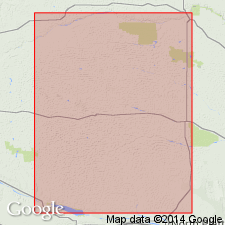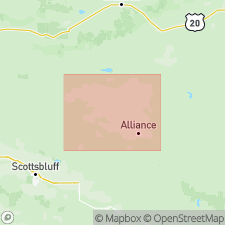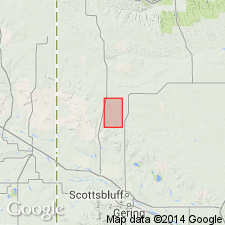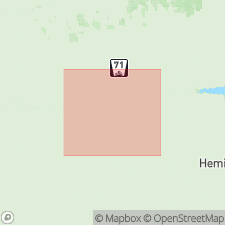
- Usage in publication:
-
- Marsland formation
- Modifications:
-
- Revised
- AAPG geologic province:
-
- Denver basin
Summary:
Pg. 226, 227; 1939, GSA Bull., v. 50, no. 8, p. 1253-1254, 1258, 1264 (table 1), 1266 (table 2). Marsland formation. Included in Hemingford group (new). Thickness 125 to 200 feet. Separated from underlying Harrison formation by structural and erosional unconformity. Unit has been referred to as "Upper Harrison" but was not part of Harrison as defined by Hatcher; neither was it part of Scott's (1894) Nebraska beds as Hatcher believed, nor was it included in Darton's Arikaree.
Source: US geologic names lexicon (USGS Bull. 1200, p. 2397-2398).
- Usage in publication:
-
- Marsland formation
- Modifications:
-
- Original reference
- Dominant lithology:
-
- Sandstone
- AAPG geologic province:
-
- Chadron arch
Schultz, C.B., 1938, The Miocene of western Nebraska: American Journal of Science, 5th series, v. 35, no. 210, p. 441-444.
Summary:
p. 443, 444. Marsland formation. Name applied to deposits which immedately overlie Arikaree group and which are faunally and lithologically distinct from typical Arikaree. Overlies Harrison formation (as defined by Hatcher); underlies Sheep Creek formation. Where best exposed, in region around Marsland, includes some 150 feet of buff and gray soft sandstones. Consists, in part, of valley fills and in some places mantles slopes of large valleys. On basis of fauna, should provisionally be considered as lower part of upper Miocene. [See also Harrison entry.]
Type area: southwest of Marsland, along Niobrara River, in secs. 23 to 27, T. 28 N., R. 52 W., and secs. 19 and 30, T. 28 N., R. 51 W., Box Butte Co., northwestern NE.
Source: US geologic names lexicon (USGS Bull. 1200, p. 2397-2398).
- Usage in publication:
-
- Marsland formation*
- Modifications:
-
- Areal extent
- AAPG geologic province:
-
- Chadron arch
Cady, R.C., 1940, The Box Butte member of the Sheep Creek formation, Nebraska: American Journal of Science, v. 238, no. 9, p. 663-667.
Summary:
Pg. 663-667. Marsland formation. Underlies Box Butte member (new) of Sheep Creek formation. [Lugn (1939) states that this unit has been included with and measured as part of Marsland formation on which it rests unconformably at most places, where no separating Sheep Creek valley fill deposits occur to reveal true relationship.]
Source: US geologic names lexicon (USGS Bull. 1200, p. 2397-2398).
- Usage in publication:
-
- Marsland formation
- Modifications:
-
- Revised
- AAPG geologic province:
-
- Denver basin
Cook, H.J., and Gregory, J.T., 1941, Mesogaulus praecursor, a new rodent from the Miocene of Nebraska: Journal of Paleontology, v. 15, no. 5, p. 549-552.
Summary:
Pg. 549-552. Fauna described from "Upper Harrison" beds. These beds are distinct from overlying Marsland formation and contain fauna more closely related to Arikaree than to Marsland. Hence, Marsland as defined by Schultz [1938] includes two separable formations: the "Upper Harrison" beds and the higher previously unnamed deposits, exposed east of Marsland. Because of faunal distinctness of beds around Marsland from the "Upper Harrison", it seems desirable to restrict use of term Marsland to deposits at type locality described by Schultz. Restricted Marsland is equivalent to the "unnamed beds" between the "Upper Harrison" and Sheep Creek, shown in columnar section of region by Cook and Cook, 1933 (Nebraska Geol. Survey Paper, no. 5, p. 44). Although acknowledging undesirability of term "Upper Harrison", authors do not propose name for these earliest deposits of Hemingford group which lie below restricted Marsland.
Source: US geologic names lexicon (USGS Bull. 1200, p. 2397-2398).
- Usage in publication:
-
- Marsland formation
- Modifications:
-
- Areal extent
- AAPG geologic province:
-
- Chadron arch
- Denver basin
Schultz, C.B., 1941, [Title unknown] [abs.]: Geological Society of America Bulletin, Boston, MA, December, 1941, v. 52, no. 12, pt. 2, p. 1990.
Summary:
Marsland formation. Traced from type area into Colorado, South Dakota, and Wyoming. A distinct lithologic unit in Nebraska and Wyoming areas, and, although in Colorado and South Dakota these deposits are less typical, the faunas are equivalent.
Source: US geologic names lexicon (USGS Bull. 1200, p. 2397-2398).

- Usage in publication:
-
- Marsland formation
- Modifications:
-
- Mapped
- Dominant lithology:
-
- Sandstone
- Silt
- AAPG geologic province:
-
- Chadron arch
Summary:
Pg. 20, 26-32, pl. 1. Marsland formation. Described in Box Butte County, Nebraska, where it overlies Harrison sandstone and underlies Sheep Creek formation, in many areas the Box Butte member. Consists of impure, fine-grained, clay-cemented sandstone alternating with beds of massive silt and some coarse channel sands. Nebraska Geological Survey places Marsland and Sheep Creek formations in Hemingford group. This classification not used by U.S. Geological Survey.
Source: US geologic names lexicon (USGS Bull. 1200, p. 2397-2398).
- Usage in publication:
-
- Marsland formation
- Modifications:
-
- Revised
McKenna, M.C., 1965, Stratigraphic nomenclature of the Miocene Hemingford Group, Nebraska: American Museum Novitates, no. 2228, 21 p., Sept.
Summary:
Marsland Formation of Hemingford Group. Stratigraphically restricted to lower part of Marsland Formation of Schultz (1938); = "Upper Harrison" of earlier workers. Is basal formation of Hemingford Group. Lies below Runningwater Formation of Hemingford Group and above Harrison Formation of Arikaree Group.
Source: Publication.

- Usage in publication:
-
- Marsland Formation
- Modifications:
-
- Areal extent
- AAPG geologic province:
-
- Denver basin
Summary:
Pg. 292-295, 317, figs. 1, 6. Marsland Formation of Hemingford Group. Authors follow classification of McKenna (1965). = "Upper Harrison" beds of Peterson, 1907 [1906] (Carnegie Mus. Nat. Hist. Annals, v. 4, no. 1, art. 3, p. 23, fig. 1). [Excludes? upper Marsland of Schultz and Falkenbach, 1947 (Amer. Mus. Nat. Hist. Bull., v. 88, art. 4) which = Runningwater Formation of Cook, 1965 (Amer. Mus. Nat. Hist. Nov., no. 2227, Aug.).] Unconformably overlies Harrison Formation of Arikaree Group northwest of study area, on north and west sides of "Tower Hill," in vicinity of "APHELOPS Draw," Sioux County, northwestern Nebraska (fig. 6 section E, btw. p. 304-305). Age is considered early Miocene (early Hemingfordian NALMA), based on stratigraphic relations.
[Tower Hill shown on fig. 1 northwest of study area; =? radio tower a few mi south of Agate, in SE/4 NE/4 sec. 12, T. 26 N., R. 56 W., Chalk Buttes NE 7.5-min quadrangle, Sioux Co., northwestern NE.]
Source: Publication.

- Usage in publication:
-
- Marsland formation
- Modifications:
-
- Revised
- AAPG geologic province:
-
- Chadron arch
- Denver basin
Summary:
Geol. map, corr. charts. Marsland formation. Divided into (descending): Runningwater Member (revised), wavy-bedded sandstone and massive silty sandstone with gravel composed of igneous and metamorphic pebbles; and unnamed lower member (="Upper Harrison" of Peterson, 1909), massive, brown, silty sandstone and lithic conglomerates. Overlies Harrison Formation or, where absent, Monroe Creek Formation; underlies Box Butte Formation.
Source: Publication.
- Usage in publication:
-
- "Upper Harrison" beds
- [Marsland Formation]
- Modifications:
-
- Revised
- AAPG geologic province:
-
- Denver basin
Swinehart, J.B., Souders, V.L., DeGraw, H.M., and Diffendal, R.F., Jr., 1985, Cenozoic paleogeography of western Nebraska: Society of Economic Paleontologists and Mineralogists, Rocky Mountain Section, Rocky Mountain Paleogeography Symposium, v. 3, p. 209-229., Reprinted as University of Nebraska-Lincoln, Conservation and Survey Division, Reprint Series, no. 52
Summary:
Pg. 211, 212 (fig. 4), 213 (table 1). "Upper Harrison" beds of Arikaree Group. Transferred to Arikaree Group [†Hemingford Group abandoned]. Consists of brown volcaniclastic sandy siltstones. Grayish-brown to gray silty fine-grained sandstones and locally occurring coarser-grained sandstones at the base. Silica-cemented horizons common in west. Generally grades from grayish-brown silty sandstones in west to brown siltstone in northeast. Maximum thickness 300 feet (91 m). Is older than Runningwater Formation of Ogallala Group and younger than Monroe Creek and Harrison Formations of Arikaree Group. Age is Miocene, [shown on fig. 4 from about 21 to 19 Ma +/-].
Source: Publication.
For more information, please contact Nancy Stamm, Geologic Names Committee Secretary.
Asterisk (*) indicates published by U.S. Geological Survey authors.
"No current usage" (†) implies that a name has been abandoned or has fallen into disuse. Former usage and, if known, replacement name given in parentheses ( ).
Slash (/) indicates name conflicts with nomenclatural guidelines (CSN, 1933; ACSN, 1961, 1970; NACSN, 1983, 2005, 2021). May be explained within brackets ([ ]).

